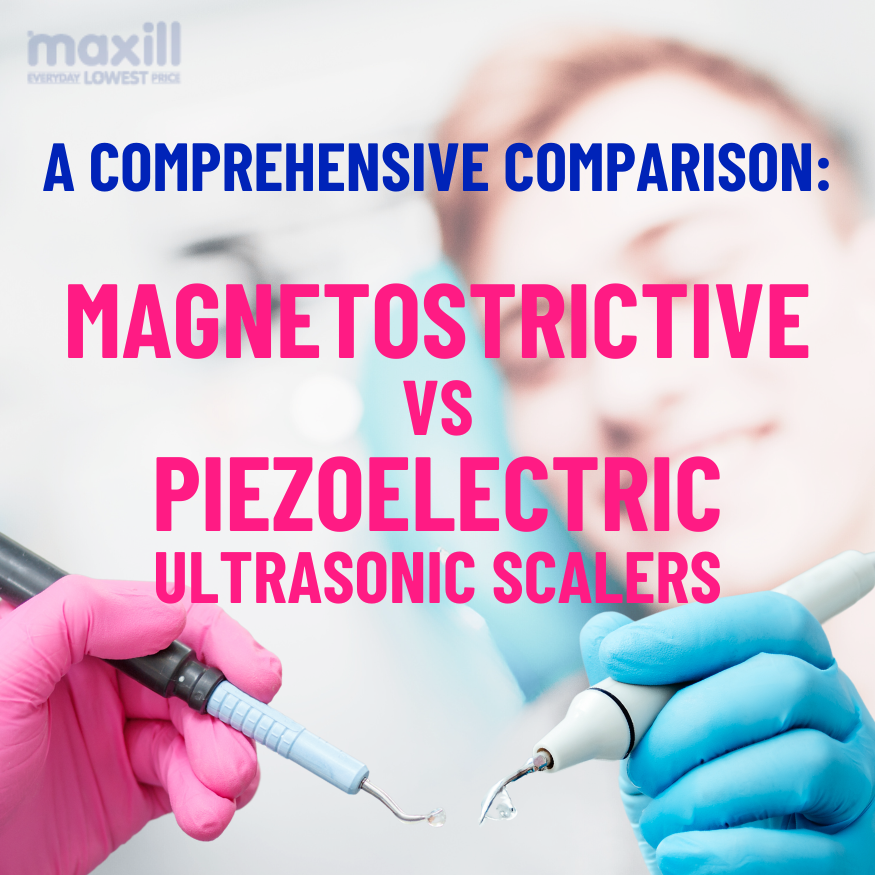A Comprehensive Comparison: Magnetostrictive VS. Piezoelectric Ultrasonic Scalers

Dental is a fundamental procedure in oral healthcare, essential for maintaining optimal dental hygiene and preventing oral diseases. Among the various tools and techniques employed in dental debridement, two prominent methods stand out: magnetostrictive scalers, and piezoelectric scalers. Understanding the differences between these two ultrasonic scalers is crucial for dental professionals to make informed decisions about their clinical practices and provide the best possible care for their patients.
Magnetostrictive scalers and piezoelectric scalers operate on distinct principles, each offering unique advantages and drawbacks. In this comprehensive comparison, we dive a little deeper into the intricacies of these two methods, exploring their mechanisms of action, applications, and the highlights and challenges associated with each.
As we embark on this exploration, we will uncover the inner workings of magnetostrictive scalers, which harness the power of magnetostriction to generate vibrations for efficient dental debridement. We’ll also shine light on piezoelectricity to produce precise and controlled vibrations for debridement procedures.
Let’s take a deeper dive into the realm of ultrasonic dental debridement technology and unravel the mysteries behind these essential tools of the trade.
Part 1: Understanding Magnetostrictive Ultrasonic Scalers
Definition and Principle of Operation
Magnetostrictive scalers are an essential tool used in dental debridement procedures, employing the principle of magnetostriction to generate high-frequency vibrations. Magnetostriction is a property exhibited by certain materials, such as ferromagnetic alloys, wherein the material changes shape in the response to an applied magnetic field. In magnetostrictive scalers, this property is harnessed to create mechanical vibrations necessary for effective removal of dental plaque and calculus buildup.
These scaler inserts consist of a stack of thin metal strips made of ferromagnetic materials, typically nickel or cobalt alloys, sandwiched between two metal plates. When subjected to an alternating magnetic field generated by a handpiece, the metal strips undergo rapid expansion and contraction, resulting in vibratory motion. This vibration is then transmitted to the scaler tip, which has direct contact with the tooth surface to dislodge and remove deposits.
Functionality
Magnetostrictive ultrasonic scalers function by converting electrical energy into mechanical vibrations through the process of magnetostriction. When an alternating current is passed through the metal strips within the scaler insert, they rapidly alternate between magnetized and demagnetized states, causing them to expand and contract at ultrasonic frequencies. This cyclical motion generates mechanical vibrations that are transmitted to the scaler tip, resulting in effective removal of dental deposits.
Uses and Applications
Magnetostrictive ultrasonic scalers find widespread use in various dental debridement applications, ranging from routine dental hygiene procedures to more complex periodontal treatments. They are particularly effective in removing tenacious calculus deposits and subgingival plaque and tartar thanks to their powerful vibratory motion.
These ultrasonic scalers are versatile tools capable of addressing a wide range of clinical scenarios, making them indispensable in modern dental practice.
These inserts are commonly employed in both supragingival and subgingival debridement procedures, allowing dental professionals to achieve optimal results while minimizing patient discomfort. Whether used for routine cleanings, periodontal debridement, or implant maintenance, magnetostrictive ultrasonic scalers offer reliable performance and consistent outcomes across various clinical settings.
HIGHLIGHTS and CHALLENGES of Magnetostrictive Ultrasonic Scaler
HIGHLIGHTS
-
-
-
-
-
-
-
- Efficient removal of plaque and calculus
- Versatile applications in supragingival and subgingival debridement
- Elliptical motion enhances cleaning efficacy.
- Suitable for use with various scaler tip designs
- Compatible with most dental ultrasonic units
-
-
-
-
-
-
CHALLENGES
-
-
-
-
-
-
-
- Generates heat during prolonged use.
- May cause discomfort for patients with sensitive teeth.
- Requires periodic maintenance and calibration.
- Relatively noisy compared to other ultrasonic debridement methods.
- Potential for hand fatigue during extended procedures.
-
-
-
-
-
-
Part 2: Understanding Piezoelectric Ultrasonic Scalers

Definition and Principle of Operation
Piezoelectric ultrasonic scalers are advanced dental instruments that utilize the piezoelectric effect to generate ultrasonic vibrations for dental debridement. The piezoelectric effect is a phenomenon observed in certain materials, such as quartz or ceramics, wherein an electric voltage applied to the material induces mechanical deformation. In piezoelectric scalers, this property is leveraged to create precise and controlled vibrations necessary for effective removal of dental plaque and calculus.
These scalers typically consist of a handpiece, a piezoelectric transducer, and a scaler tip. The handpiece houses the electronic components responsible for generating the electrical signal, while the piezoelectric transducer converts this signal into mechanical vibrations. The scaler tip, usually made of titanium or other durable materials, is the working end of the instrument that has direct contact with the tooth surface during debridement.
Functionality
Piezoelectric scalers function by converting electrical energy into mechanical vibrations through the piezoelectric effect. When an alternating current is applied to the piezoelectric crystals within the transducer, they undergo rapid expansion and contraction, generating ultrasonic vibrations with precise frequency and amplitude. These vibrations are then transmitted to the scaler tip, where they are utilized to remove dental deposits with minimal tissue trauma.
Unlike magnetostrictive scalers, which produce elliptical vibrations, piezoelectric scalers generate linear vibrations perpendicular to the longitudinal axis of the scaler tip. This linear motion enables precise control and enhanced visibility during debridement procedures, allowing dental professionals to target specific areas with greater accuracy.
Uses and Applications
Like the magnetostrictive, piezoelectric ultrasonic scalers are also a versatile tool widely used in various dental debridement applications, including routine cleanings, routine or complex periodontal therapy, and implant maintenance. They are particularly effective in removing supra- and subgingival calculus deposits, as well as stains and plaque, thanks to their precise and controlled vibratory motion.
These scalers are well-suited for delicate procedures requiring fine manipulation and access to narrow or hard-to-reach areas. The ability to adjust the frequency and power settings of piezoelectric scalers allows for customization according to the specific needs of each patient and clinical scenario.
HIGHLIGHTS and CHALLENGES of Piezoelectric Ultrasonic Scalers
HIGHLIGHTS
-
-
-
-
-
-
- Precise and controlled vibration for efficient debridement
- Reduced risk of tissue trauma compared to magnetostrictive scalers.
- Greater visibility and access to tight spaces
- Customizable frequency and power settings
- Quieter operation compared to magnetostrictive scalers.
-
-
-
-
-
CHALLENGES
-
-
-
-
-
-
- Higher initial cost compared to magnetostrictive scalers.
- Limited compatibility with certain scaler tip designs
- Requires specialized training for optimal use.
- May cause discomfort for patients with sensitive teeth or gums.
- Piezoelectric scaler tips are more fragile and prone to breakage.
-
-
-
-
-
Part 3: Comparing Magnetostrictive and Piezoelectric
Understanding the differences between magnetostrictive and piezoelectric ultrasonic scalers is key for dental professionals seeking to optimize patient care and clinical outcomes. To aid in this decision-making process, here is a compiled and comprehensive comparison chart highlighting key factors such as efficiency, versatility, patient comfort, maintenance, durability, and cost considerations.
This comparison can serve as a valuable resource for dental practices evaluation of which scaler type best aligns with their specific needs and priorities.
|
|
MAGNETOSTRICTIVE |
PIEZOELECTRIC |
|
Efficiency and Effectiveness |
|
|
|
Versatility |
|
|
|
Patient Comfort |
|
|
|
Maintenance and Durability |
|
|
|
Cost Considerations |
|
|
In Summary
Dental debridement remains a cornerstone procedure in oral healthcare, crucial for maintaining optimal dental hygiene and preventing oral diseases. Magnetostrictive and piezoelectric ultrasonic scalers represent two prominent methods employed in dental debridement, each with its own set of advantages and drawbacks.
The choice between magnetostrictive and piezoelectric ultrasonic scalers can significantly impact patient care. Magnetostrictive scalers offer efficiency and versatility, while piezoelectric scalers provide precision and enhanced patient comfort. By weighing factors such as efficiency, versatility, patient comfort, maintenance, durability, and cost, dental professionals can make informed decisions to tailor their practices to meet the specific needs of their patients.
As technology advances and new innovations emerge, staying informed about the latest developments ensures that dental practices can continue to deliver high-quality oral healthcare and improve patient outcomes. Both magnetostrictive and piezoelectric ultrasonic scalers remain indispensable tools in the dental profession, empowering practitioners to achieve optimal results and promote overall wellness.
- Yousefimanesh, H., Robati, M., Kadkhodazadeh, M., & Molla, R. (2012). A comparison of magnetostrictive and piezoelectric ultrasonic scaling devices: an in vitro study. Journal of periodontal & implant science, 42(6), 243–247. https://doi.org/10.5051/jpis.2012.42.6.243
- J Can Dent Assoc 2011;77:b113
- You, X., Wu, X., & Chen, S. (2024). Effects of a new magnetostrictive ultrasonic scaler and a traditional piezoelectric ultrasonic scaler on root surfaces and patient complaints. Scientific reports, 14(1), 6601. https://doi.org/10.1038/s41598-024-57037-7
- Singh, S., Uppoor, A., & Nayak, D. (2012). A comparative evaluation of the efficacy of manual, magnetostrictive and piezoelectric ultrasonic instruments--an in vitro profilometric and SEM study. Journal of applied oral science : revista FOB, 20(1), 21–26. https://doi.org/10.1590/s1678-77572012000100005








